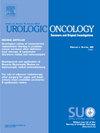Enhancing outcomes in metastatic renal cell carcinoma: Integrating precision radiotherapy with targeted therapy and anti-PD-1 immunotherapy
IF 2.4
3区 医学
Q3 ONCOLOGY
Urologic Oncology-seminars and Original Investigations
Pub Date : 2025-04-24
DOI:10.1016/j.urolonc.2025.03.016
引用次数: 0
Abstract
Purpose
This study assesses the safety and disease control outcomes in metastatic renal cell carcinoma (mRCC) patients undergoing concurrent tyrosine kinase inhibitors (TKI), immune checkpoint inhibitors (ICIs), and high-dose stereotactic ablative body radiotherapy (SABR) .
Patients and Methods
Between February 2020 to May 2023, 54 mRCC patients receiving vascular endothelial growth factor (VEGF) targeted therapy and ICIs with high-dose radiotherapy (RT) were included. Genetic testing was performed on 25 pathology samples using the Acornmed 70™ panel. Endpoints included progression-free survival (PFS) 1, PFS2 (time to progression to change systemic therapy), LRFS, OS, disease control rate (DCR) and safety. Kaplan‒Meier analysis was used for time-to-event endpoints. HRs and 95% CIs were calculated. R version 4.3.1 was used for statistical analysis
Results
In this study involving 54 patients, SABR was employed in 81% of cases, achieving a 98% DCR. Median PFS1 was 16.9 months, with 2-year PFS2 and OS rates of 53% and 81%, respectively. Subgroup analysis revealed that early RT significantly improved PFS1 (P = 0.023). VHL-driven mRCC demonstrated a trend toward improved PFS1, statistical significance was not reached due to the limited sample size (P = 0.3). Safety analysis indicated grade 3 or 4 treatment-related adverse events in 50% of patients, with no grade 5 events.
Conclusions
The investigated trimodality treatment strategy is both safe and effective, resulting in prolonged PFS without requiring a change in systemic treatment. Overall, early RT intervention may offer additional benefits. Future research should provide molecular-level insights into treatment response.
提高转移性肾细胞癌的预后:将精确放疗与靶向治疗和抗pd -1免疫治疗相结合。
目的:本研究评估转移性肾癌(mRCC)患者同时接受酪氨酸激酶抑制剂(TKI)、免疫检查点抑制剂(ICIs)和高剂量立体定向消融体放疗(SABR)的安全性和疾病控制结果。患者和方法:在2020年2月至2023年5月期间,54例mRCC患者接受血管内皮生长因子(VEGF)靶向治疗和ICIs联合高剂量放疗(RT)。采用Acornmed 70™面板对25份病理样本进行基因检测。终点包括无进展生存期(PFS) 1、PFS2(从进展到改变全身治疗的时间)、LRFS、OS、疾病控制率(DCR)和安全性。Kaplan-Meier分析用于时间到事件的终点。计算hr和95% ci。结果:本研究纳入54例患者,81%的病例采用了SABR, DCR达到98%。中位PFS1为16.9个月,2年PFS2和OS率分别为53%和81%。亚组分析显示,早期放疗显著改善PFS1 (P = 0.023)。vhl驱动的mRCC表现出改善PFS1的趋势,由于样本量有限,未达到统计学意义(P = 0.3)。安全性分析显示50%的患者出现3级或4级治疗相关不良事件,无5级不良事件。结论:所研究的三段式治疗策略既安全又有效,无需改变全身治疗即可延长PFS。总的来说,早期放疗干预可能会带来额外的好处。未来的研究应该提供分子水平的治疗反应的见解。
本文章由计算机程序翻译,如有差异,请以英文原文为准。
求助全文
约1分钟内获得全文
求助全文
来源期刊
CiteScore
4.80
自引率
3.70%
发文量
297
审稿时长
7.6 weeks
期刊介绍:
Urologic Oncology: Seminars and Original Investigations is the official journal of the Society of Urologic Oncology. The journal publishes practical, timely, and relevant clinical and basic science research articles which address any aspect of urologic oncology. Each issue comprises original research, news and topics, survey articles providing short commentaries on other important articles in the urologic oncology literature, and reviews including an in-depth Seminar examining a specific clinical dilemma. The journal periodically publishes supplement issues devoted to areas of current interest to the urologic oncology community. Articles published are of interest to researchers and the clinicians involved in the practice of urologic oncology including urologists, oncologists, and radiologists.

 求助内容:
求助内容: 应助结果提醒方式:
应助结果提醒方式:


